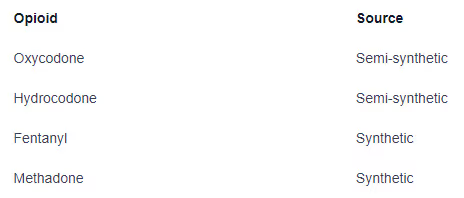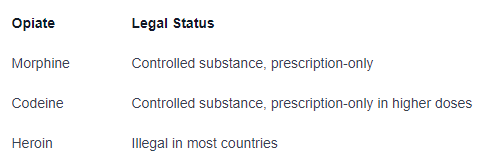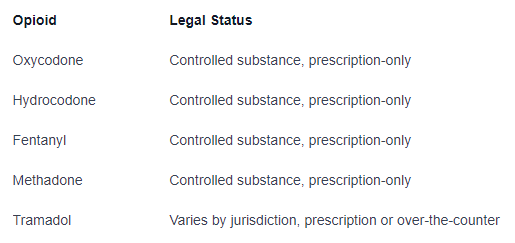Opiates or Opioids: What's the difference?

Understanding Opiates and Opioids
To fully grasp the difference between opiates and opioids, it's essential to understand their individual definitions and how they are classified.
Definition of Opiates
Opiates are a class of drugs derived directly from opium, which is obtained from the poppy plant. These drugs contain natural compounds, such as morphine and codeine, which are extracted from the opium poppy. Opiates have been used for centuries for their pain-relieving properties and have a long history of medical use.
Definition of Opioids
Opioids, on the other hand, are a broader category of drugs that encompass both natural and synthetic substances. While some opioids, like morphine and codeine, are derived from opium, others are entirely synthetic or semi-synthetic, such as fentanyl and oxycodone. Opioids are designed to replicate the effects of natural opiates, targeting the same receptors in the brain and producing similar pain-relieving effects.
To summarize the difference between opiates and opioids, opiates refer specifically to drugs derived from opium, while opioids encompass a broader range of substances, including natural, synthetic, and semi-synthetic drugs with opium-like effects.
Understanding the distinction between these terms is crucial for discussions surrounding their use, effects, and potential risks.
Chemical Composition and Origin
To understand the difference between opiates and opioids, it's important to examine their chemical composition and origin. While both substances are derived from the opium poppy plant, there are distinguishing factors that set them apart.
Opiate Sources and Composition
Opiates are natural substances derived directly from the opium poppy plant, scientifically known as Papaver somniferum. The primary active compounds found in opiates are morphine and codeine. Morphine is a potent analgesic (pain reliever) and is considered the prototype of all opioids. Codeine, on the other hand, is less potent but still possesses analgesic and cough suppressant properties.

Opioid Sources and Composition
Opioids, on the other hand, include a broader category of substances that can be natural, semi-synthetic, or entirely synthetic. While some opioids are derived from the opium poppy plant like opiates, others are created through chemical synthesis. Opioids work by binding to opioid receptors in the body, producing similar effects to opiates.
Here are some examples of opioids and their sources:

It's important to note that while opiates and opioids have similarities in their chemical composition and origin, the term "opioid" is often used more broadly to encompass both natural opiates and synthetic opioids.
Understanding the chemical composition and origin of opiates and opioids provides a foundation for comprehending the differences between the two. In the subsequent sections, we will explore their medical uses, legality, regulation, and potential for misuse and addiction.
Medical Use and Effects
When it comes to the medical field, both opiates and opioids play important roles in managing pain and providing relief. However, there are some distinctions between the medical uses and effects of these substances.
Medical Uses of Opiates
Opiates, which are derived from opium, have been used for centuries to alleviate pain. They have a long history of use in various medical settings. Opiates are often prescribed for acute pain management, such as post-surgical pain or pain associated with a severe injury. They are also used to manage chronic pain in certain cases.
Some common medical uses of opiates include:
- Pain relief after surgery or injury
- Management of severe chronic pain, such as cancer-related pain
- Treatment of acute pain, such as labor pain or kidney stones
Opiates work by binding to specific receptors in the brain and spinal cord, reducing the perception of pain. They can induce feelings of euphoria and relaxation, which contribute to their potential for misuse and addiction.
Medical Uses of Opioids
Opioids, on the other hand, encompass a broader category of substances that includes both natural opiates and synthetic or semi-synthetic compounds. Opioids include not only drugs derived from opium but also those that are synthesized in a laboratory. They are often used as a term to refer to all substances, whether natural or synthetic, that bind to opioid receptors in the body.
Medical uses of opioids are similar to those of opiates, but with some additional considerations. Opioids are commonly prescribed for pain management, both acute and chronic. They can be used in various forms, including oral medications, transdermal patches, and injectables.
Some medical uses of opioids include:
- Pain relief after surgery or injury
- Management of chronic pain, including conditions like osteoarthritis or neuropathic pain
- Treatment of severe pain in palliative care or end-of-life situations
Opioids work by binding to opioid receptors in the brain and body, similar to opiates. They provide pain relief and can induce feelings of relaxation and sedation. However, opioids also have the potential for misuse, dependence, and addiction.
It's important to note that the medical use of both opiates and opioids should always be under the guidance and supervision of a healthcare professional. Proper dosing and careful monitoring are essential to ensure the safe and effective use of these medications.
Differences in Legality and Regulation
When it comes to the legal status and regulation of opiates and opioids, there are distinct differences between the two.
Legal Status of Opiates
Opiates, which are derived from the opium poppy plant, have a long history of use in medicine and recreation. The legal status of opiates varies across different jurisdictions, but generally, they are regulated substances due to their potential for misuse and addiction. In many countries, opiates are classified as controlled substances and are subject to strict regulations, including prescription requirements and limitations on dispensing.
Here is a general overview of the legal status of some commonly known opiates:

It's important to note that the legal status of opiates can vary depending on the specific jurisdiction and its classification of controlled substances.
Legal Status of Opioids
Opioids, on the other hand, encompass a broader category of drugs that include both naturally derived substances (like opiates) and synthetic or semi-synthetic compounds. The legal status of opioids also varies depending on the particular drug and jurisdiction.
Here is a general overview of the legal status of some commonly known opioids:

The legal status of opioids can vary not only by jurisdiction but also by the specific drug and its intended use. Some opioids, like fentanyl, may have stricter regulations due to their high potency and potential for misuse.
It's crucial to consult local laws and regulations to understand the legal status of opiates and opioids in your specific area. Additionally, it's essential to use these substances only as prescribed by a healthcare professional to ensure safety and avoid potential legal consequences.
Understanding the legal framework surrounding opiates and opioids is an important step in promoting responsible use and preventing misuse and addiction.
Potential for Misuse and Addiction
When it comes to opiates and opioids, both substances have the potential for misuse and addiction. Understanding the addictive nature of these drugs is crucial in recognizing the risks associated with their use.
Addiction Potential of Opiates
Opiates, which are derived from opium, have long been recognized for their addictive properties. These drugs bind to specific receptors in the brain, spinal cord, and gastrointestinal tract, resulting in pain relief and feelings of euphoria. However, the same mechanisms that make opiates effective in managing pain can also lead to dependency and addiction.
The addictive potential of opiates can be attributed to their ability to produce intense pleasure and reward in the brain. Over time, the brain adapts to the presence of opiates, leading to tolerance and the need for higher doses to achieve the desired effects. This can quickly spiral into dependence and addiction, where individuals experience intense cravings and withdrawal symptoms when attempting to stop or reduce their opiate use.
Addiction Potential of Opioids
Opioids, on the other hand, refer to a broader class of drugs that include both natural and synthetic substances. While opiates are derived from opium, opioids encompass a wider range of compounds that mimic the effects of opiates. This includes prescription pain medications like oxycodone and hydrocodone, as well as illicit drugs like heroin.
Like opiates, opioids can also be highly addictive. These drugs act on the same receptors in the brain and body, producing similar analgesic and euphoric effects. The misuse of prescription opioids, in particular, has become a significant public health concern, with many individuals transitioning from legitimate medical use to addiction.
To better understand the potential for addiction, it's important to consider the potency and dosage of different opioids. Some opioids, such as fentanyl, are significantly more potent than others and carry a higher risk of overdose. The table below provides a general comparison of the potency of various opioids:

It's crucial to note that addiction is a complex issue influenced by various factors, including genetics, environment, and individual susceptibility. Seeking professional help and utilizing appropriate treatment approaches are essential for addressing opioid addiction and reducing the associated risks.
By understanding the addictive potential of both opiates and opioids, individuals can make informed decisions about their use and seek appropriate support if needed. It is vital to prioritize education, prevention, and access to evidence-based treatments to combat the opioid crisis and promote safe and responsible use of these substances.
Understanding Opiates and Opioids
To comprehend the difference between opiates and opioids, it is essential to examine their definitions and characteristics. Both substances belong to a class of drugs known for their pain-relieving properties. Let's delve into the details.
Definition of Opiates
Opiates are a subset of drugs derived from the opium poppy plant, Papaver somniferum. These drugs include natural compounds such as morphine and codeine. Opiates are classified as narcotics and have been used for centuries to alleviate pain.
Definition of Opioids
Opioids, on the other hand, are a broader category of drugs that include both natural and synthetic substances. While some opioids are derived from opium, many are synthetically manufactured to mimic the effects of natural opiates. These synthetic opioids include medications like oxycodone, hydrocodone, and fentanyl.
Chemical Composition and Origin
To understand the differences between opiates and opioids, it is important to examine their chemical composition and sources.
Opiate Sources and Composition
Opiates are derived directly from the opium poppy plant. The opium poppy plant produces a milky substance known as opium, which contains various alkaloids including morphine and codeine. These alkaloids are then extracted and used to produce natural opiates.
Opioid Sources and Composition
Opioids, on the other hand, encompass a wider range of substances. While some opioids are derived from the opium poppy plant, many others are synthetically produced in laboratories. Synthetic opioids are designed to mimic the effects of natural opiates, but they are not derived directly from the opium poppy plant.
Medical Use and Effects
Both opiates and opioids have medical uses and can be prescribed by healthcare professionals for pain relief. However, there are differences in their specific applications.
Medical Uses of Opiates
Opiates, due to their natural origin, have been used for centuries to alleviate pain. They are commonly prescribed for acute and chronic pain management, particularly for severe pain that does not respond to other medications. Opiates can also be used as cough suppressants and to alleviate diarrhea.
Medical Uses of Opioids
Opioids, which include both natural and synthetic substances, are prescribed for similar purposes as opiates. They are commonly used for pain management, especially in cases of severe pain or when other treatment options are ineffective. Opioids may also be prescribed for certain medical procedures, such as anesthesia during surgery.
Differences in Legality and Regulation
The legal status of opiates and opioids can vary, and understanding these differences is crucial.
Legal Status of Opiates
Opiates, as natural substances derived from the opium poppy plant, are subject to strict regulations and control measures. They are classified as controlled substances in most countries and are typically available only through prescription.
Legal Status of Opioids
Opioids, which encompass both natural and synthetic substances, are also subject to legal regulations. However, the legality and availability of opioids may vary depending on the specific type of opioid and the country in which it is used. Some opioids are available only through prescription, while others may be classified as controlled substances or subject to additional restrictions.
Potential for Misuse and Addiction
Both opiates and opioids have the potential for misuse and addiction, but there are variations in their addictive properties.
Addiction Potential of Opiates
Opiates, due to their natural composition and potent effects, have a high potential for addiction. Prolonged use of opiates can lead to physical dependence and withdrawal symptoms when use is discontinued. Misuse of opiates can also result in addiction and other negative effects on physical and mental health.
Addiction Potential of Opioids
Similarly, opioids, including both natural and synthetic substances, have a significant potential for addiction. Synthetic opioids, in particular, can be highly potent and carry an increased risk of misuse and addiction. Like opiates, prolonged use of opioids can lead to physical dependence and withdrawal symptoms.
By understanding the difference between opiates and opioids, individuals can make informed decisions and healthcare professionals can ensure the safe and appropriate use of these substances for pain management. It is crucial to adhere to prescribed dosages, seek medical guidance, and be aware of the potential risks associated with these medications.
Conclusion
In conclusion, understanding the differences between opiates and opioids is essential in promoting responsible use and preventing addiction. While both substances have medical uses for pain relief, they also carry a significant risk of misuse and dependence. It is crucial to adhere to prescribed dosages, seek professional help if needed, and prioritize education and prevention efforts to combat the opioid crisis.
By working together to address this complex issue, we can ensure safe and appropriate use of these substances while reducing the associated risks.
